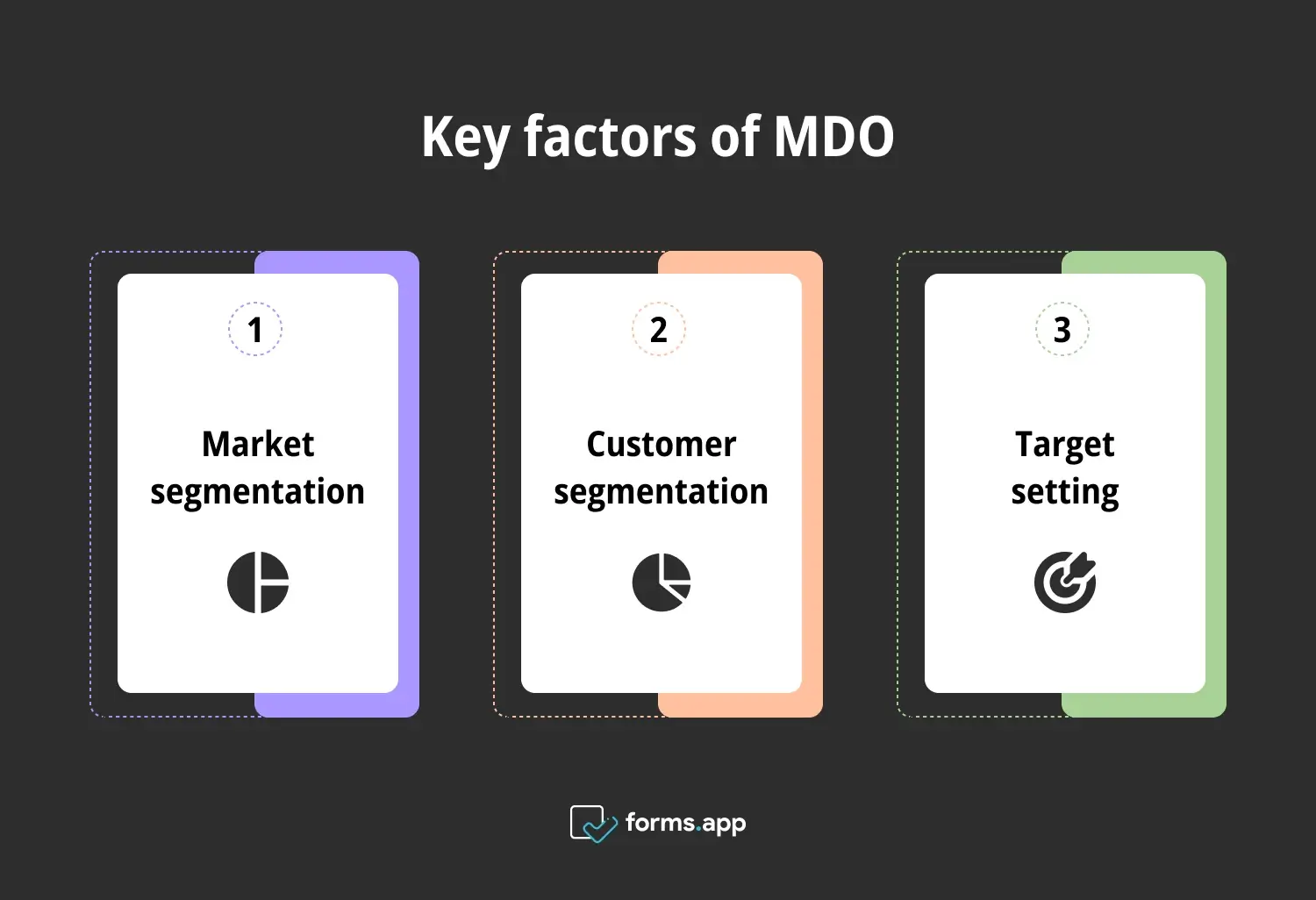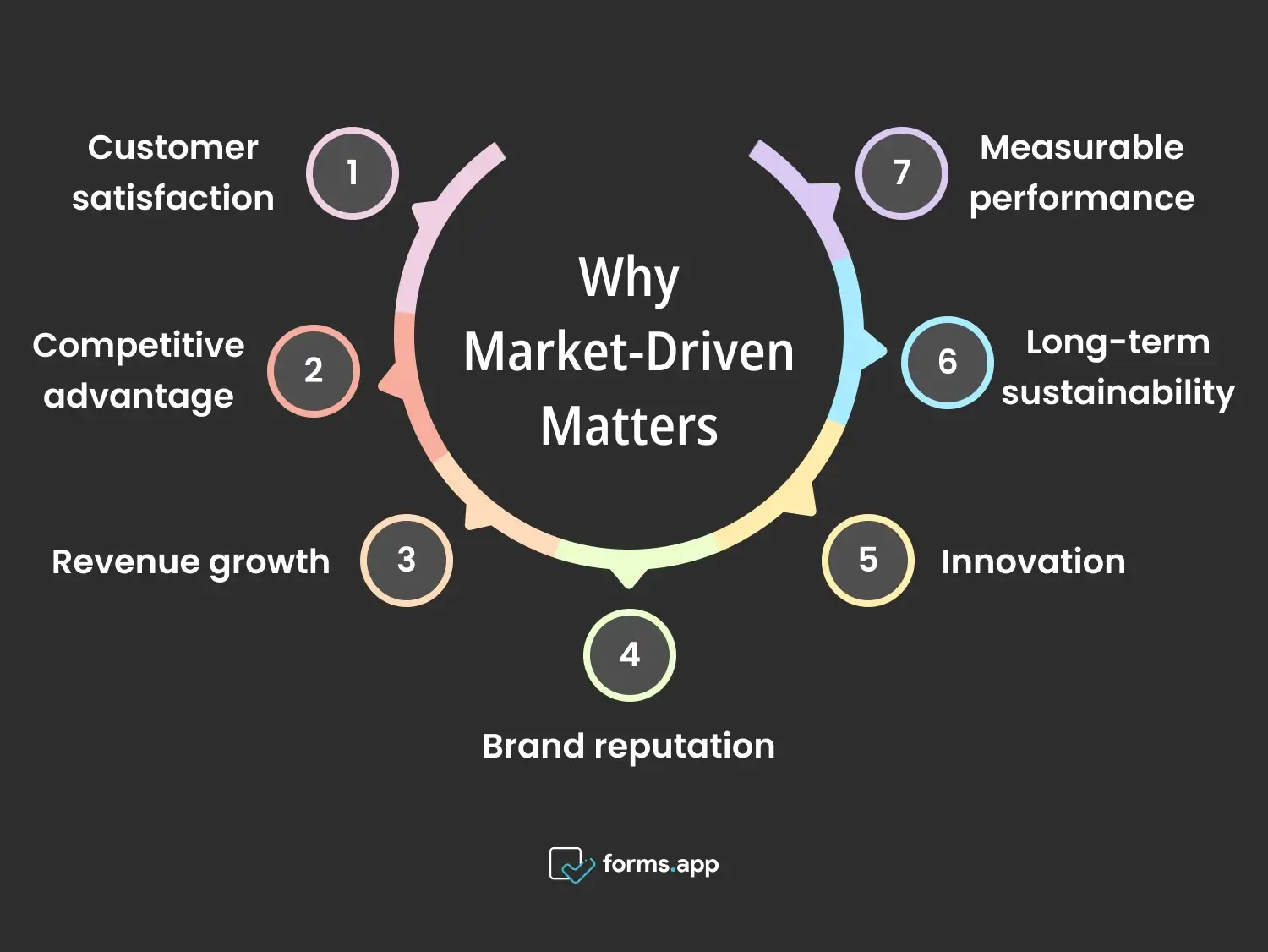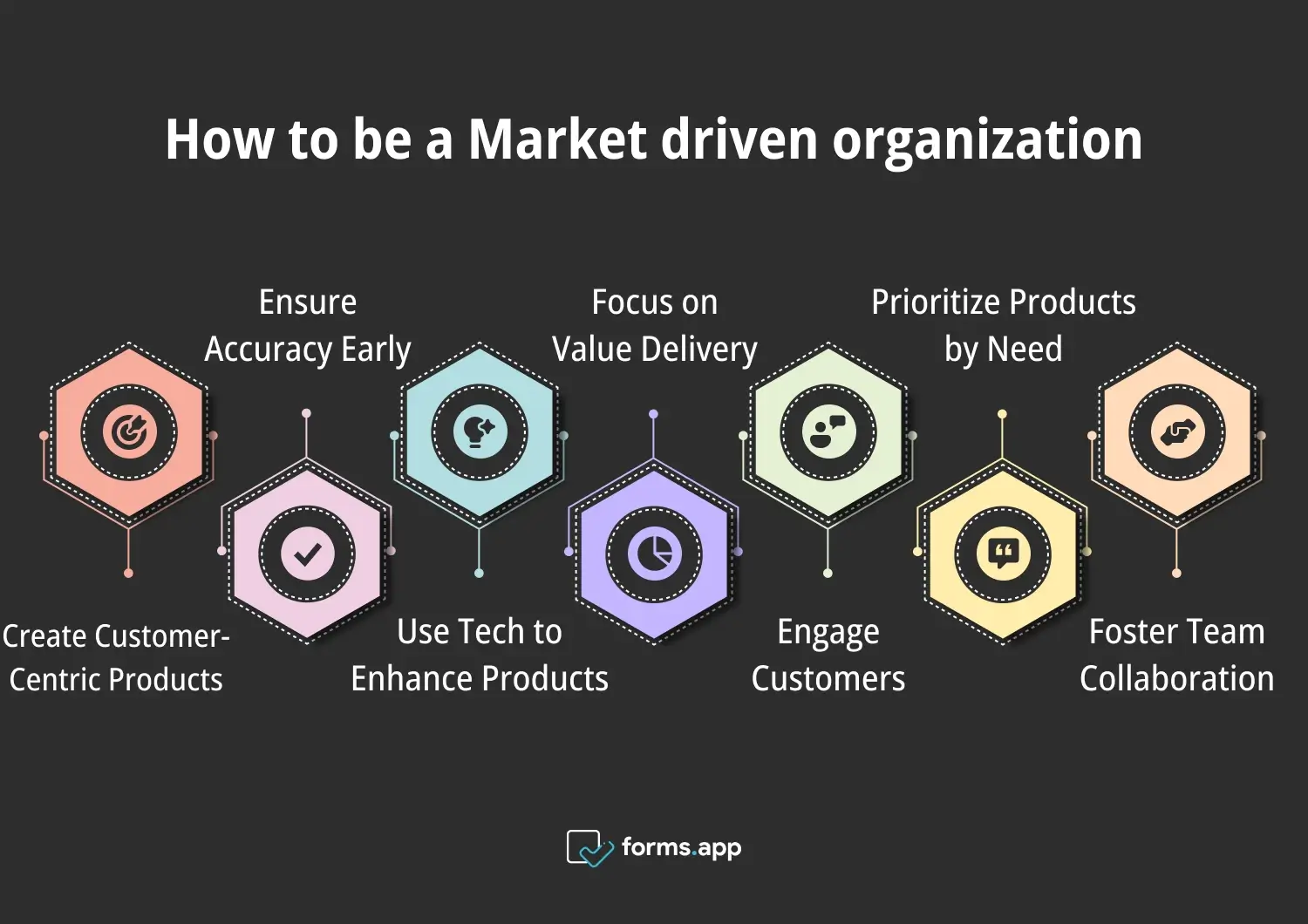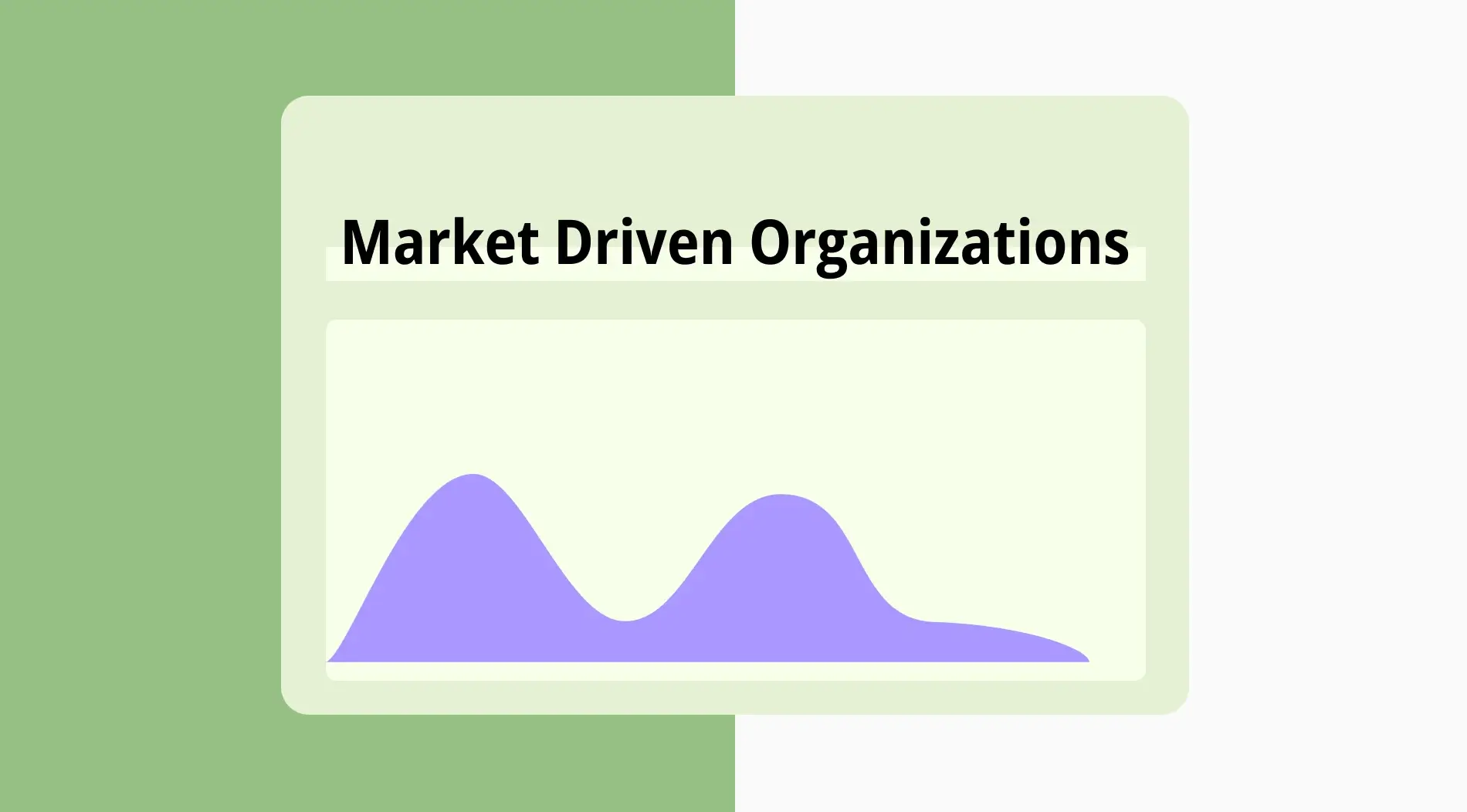A successful business takes strategic and detailed planning. A good organization always pays close attention to market change, customer satisfaction, and needs, and regularly looks for ways to transform their business towards optimum performance and success.
To achieve success and a competitive advantage, businesses should be customer-focused. A market-driven organization (MDO) comes precisely at this stage. MDO is customer-oriented, and it is vital for the business's growth and longevity. This article examines what a market-driven organization means, its importance, and how to become one.
Let’s start with the definition: What is a market-driven organization?
A market-driven organization (MDO) is a type of business that prioritizes understanding and meaning of the target customers' needs, preferences, and behaviors.
When a company clearly understands the needs and wants of its customers, it becomes easier to provide services and products accordingly. This kind of understanding helps businesses build a strong relationship and value with the customers and create tailored marketing strategies. There are 3 main key factors to MDO:

MDO key factors
1. Market segmentation
Market segmentation is about identifying the specific markets the company aims to target. The companies achieve this by segmenting based on characteristics, geographical locations, financial performance, or the specific benefits customers seek. It is also important to know the latest marketing trends and recent developments. A defined market will help businesses develop new strategies and understand market share.
2. Customer segmentation
Knowing who your customers are is vital to creating a market-driven organization. What customer profiles does your company want to target? One way to learn about this is to conduct marketing research surveys. Surveys are consistently effective in identifying a group's target audience and also allow you to specify your questions to receive the most comprehensive results for your business and product management.
3. Target setting
One of the key elements of building a successful market-driven organization is establishing targets that ensure the focus is on customers. The target is to increase customer satisfaction scores and customer lifetime value. This involves understanding the market you plan to serve and knowing your customers’ wants and priorities when purchasing a product from your company.
Importance of being a market-driven organization
There is mounting evidence demonstrating the importance of being a market-driven organization. Popular brands, such as Nestlé and Unilever, employ this market-driven technique. These companies know the needs and desires of their customers. So, they develop products that align with consumer needs.

Key points of being and MDO
The importance of a market-driven organization lies in its ability to align its operations, strategies, and goals with its target audience. Let’s have a look at some key reasons:
1. Customer satisfaction: A good market-driven organization focuses on meeting customer needs and satisfaction. When customers are satisfied, they are more likely to repeat their purchases.
2. Competitive advantage: A market-driven organization can quickly adapt and innovate by following market trends and customer feedback. This also gives them a competitive advantage.
3. Revenue growth: Market-driven organizations can drive higher sales and revenue growth by targeting the right market segments and tailoring offerings to meet certain needs.
4. Brand reputation: Maintaining a good relationship with the customer, delivering products and services to customer expectations, reinforcing the brand’s reputation, and attracting new customers.
5. Innovation: A market-driven organization constantly looks for ways to improve and get better to meet customers’ needs. This allows the organization to seize new opportunities and quickly mitigate threats.
6. Long-term sustainability: Businesses closely aligned with their markets are better positioned for long-term sustainability. This makes them more resilient to market shifts and economic changes.
7. Measurable performance: Setting up targets based on customers allows market-driven Organizations to track and improve their performance more regularly.
The capabilities of market-driven organizations are vast. Understanding your target market and audience helps your business grow, keep a competitive position in the market, develop better marketing and sales strategies, make lifelong connections with your customers, and gain new ones along the way.
How to be a market-driven organization
A market-driven organization constantly tracks customer needs and wishes to improve its products and services. Depending on market trends and demands, they should also align their strategies and structures. We have gathered seven steps that explain how to become a market-driven organization. Let’s have a look:

Steps for MDO
Step 1. Build products that meet customer needs
An efficient market-driven organization knows the needs of its customers to ensure the best products. They do extensive market research using the best marketing survey types to gather insights and data about their target audience to provide them with the right products that align with their need. This prevents them from wasting time and valuable resources on un-researched products or services.
Step 2. Ensure accuracy from the beginning
It is crucial to validate features and quality before starting development. This can start with understanding the customers’ real problems and rigorous testing of products as many times as possible before launching to avoid potential hazards. This testing and validation process also prevents the company from wasting its resources on reworking products.
Step 3. Leverage technology to enhance products
Companies are better at understanding the impact of technology on their industry better than their customers. Market-driven organizations use emerging technologies to outpace their competitors. They invest in grasping technological impacts on the market, customer perceptions, and product enhancements through new technological developments.
Step 4. Prioritise delivering value
A good market-driven organization knows the problems that customers face and delivers products and services that solve those problems. These companies invest in market research and analysis to identify the biggest issues that help with product development. Effective marketing and sales positioning help customers recognize these solutions.
Step 5. Connect with customers
One of the capabilities of market-driven organizations is to keep good relations with their customers. They liaise with their customers regularly and explore potential audiences to understand the current challenges and opportunities. Companies’ product teams collaborate with the sales department to gather feedback regularly.
Step 6. Prioritise products based on needs
Prioritization is crucial for businesses. It is important to keep the most important product roadmaps and features based on customer needs and business opportunities. Therefore, it is essential to keep an eye on customer needs and preferences, competitor offerings, and technological innovations. The bottom line is to work closely with the customers and pay attention to their feedback and requests.
Step 7. Foster cross-functional collaboration
As the last step, we are presenting the cross-functional collaboration that market-driven organizations highly value. All the departments in the organization, including sales, product development, marketing, and executive leadership, must work together in harmony. Market-driven strategies influence organizational decision-making, learning, and the company’s ongoing unique strengths and capabilities. Focusing on customer needs and values and working towards their improvement can be a common goal.
Bonus: What is a market-driven product?
Let’s define a market-driven product. As we have explained the market-driven organizations, it is also important to understand what a market-driven product is. A market-driven product is designed and developed according to a deep understanding of market demands and customer needs. This involves extensive research, attention to customer feedback, and a substantial competitive analysis.
To give an example, we can look at a globally well-known brand, The Body Shop. Customers of this company demand sustainable and ethical products that contain natural ingredients. The brand pays close attention to its customers’ requirements and needs and presents products accordingly. This market-driven approach meets the consumers’ desires, hence reinforcing the company’s success and good reputation.
Frequently asked questions about market-driven organizations
So far, we have provided insights into market-driven organizations, including what they are, what they do, and how to become one. To make sure all the points are covered, below we answer some frequently asked questions related to market-driven organizations, which may sum up some of the points we covered above in detail. Let’s have a look:
Market-driven Organizations are customer-focused - they prioritize understanding and responding to customer needs, expectations, and behavior to provide the best service in the market.
Being one of the biggest names in the market, Amazon is a great example of a market-oriented organization. Throughout its growth, it has developed important features that focus on customer problems and needs, including delivering products when the customer is not at home.
Market-driven is a business approach that prioritizes market and customer needs. This approach helps businesses develop creative and effective strategies and better products and services.
These are the industrial market, reseller market, government market, and institutional market.
a) Industrial market includes individuals or companies that buy products or services in order to produce other products.
b) Reseller market includes individuals or companies that buy goods or services produced by others in order to re-sell to buyers.
c) Government market consists of government agencies that purchase products or services to carry out the functions of the government.
d)Institutional market includes individuals or organizations, like schools or hospitals, that buy products or services for the benefit of the persons cared for by the organization.
Conclusion
Market-driven organizations are known to be highly efficient and successful at delivering good quality products and services for their target audience by keeping a close connection with their customers. This is what makes market-driven businesses structured and competitive in the market.
In this article, we have provided you with a full guide to market-driven organizations. From the definition of ‘market-driven’ to how to make your business a market-driven organization, we have covered some of the most important points of a successful business. Following these steps, you can also turn your business into a strong competitor in the market!
Elif enjoys sharing her expertise through helpful guidelines and tips about marketing and business planning. She is also a linguist who has a deep interest in maps, history, culture, and languages.



